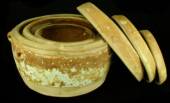REST ASSURED OF PROPER AUTHENTICITY
When ordering from these pages you are dealing directly with a team of dedicated researchers that excavated, recovered and researched every single artifact offered for sale. We encourage you to contact our Sten Sjostrand with any questions which you may have
OUR GUARANTEE:
If you are not satisfied with our artifacts, delivery service or; if you obtain an expert opinion
that a delivered item is not of the age stated by us, just return it and we will issue full refund.
Antique jars and bottles to clearance prices
All artifacts offered for sale on this page are totally intact unless stated otherwise.
Ser. No. X-89
Totally intact covered jar from the Xuande (c.1540) shipwreck This jar is from the Ban Pa Yang kiln complex in Sisatchanalai. It is dated to AD 1540. It is totally intact although most glaze covering has been lost during its long submersion in salt water. The jar will be delivered with a Certificate of Authenticity.
Sten has spent more than forty years in Southeast Asia designing and engineering various marine structures. His interest in Asia's pottery and porcelain eventually lead to his search and excavation of numbers of ancient shipwrecks. As a championship sailor Sten has extensive knowledge and interest in ancient maritime trade, ships designs and construction. It is these interests and gained knowledge that is the base for all his books and extensive lecturing.
Sten's company; Nanhai Marine Archaeology Sdn. Bhd. works with Malaysia's Department of Museums and Antiquities and can therefore offer legally excavated artifacts from these shipwrecks.
In addition to working with recovering artifacts, Sten has located number of ancient kiln sites in Thailand and in China were his shipwreck ceramics was made centuries ago. He is therefore able to offer absolute provenance on all ceramics sold via Nanhai Marine Archaeology Sdn. Bhd. and, with good conscience sign every Certificate of Authenticity supplied with the artifacts.
The maritime archaeology of Sten Sjostrand has led to major advances in the study of Asian trade and trade ceramics in Southeast Asia. His meticulous documentation of a series of nine shipwrecks from the 11th to 19th centuries reveals the early dominance of Chinese trade ceramics, a subsequent loss of the Chinese monopoly in the late 14th century when Southeast Asian ceramics entered the market, the basic parameters of the Ming gap shortages of the 14th-15th centuries, and a resurgence of Chinese wares in the 16th and 17th centuries. Just as important, Sjostrand freely shares the information from his discoveries. Researchers are welcome at his headquarters where he documents his finds and patiently answers the queries of others. A lifetime’s experience with the sea and sailing allows Sjostrand to bring new understanding to ancient ship construction, and his voluminous reading allows him to set the ships and their cargoes in historical perspective.
Dr. Roxanna M. Brown
Director.
Southeast Asian Ceramics Museum
Bangkok University, Rangsit campus
Pathum Thani 12120, Thailand
Ser. No. D-9172
RARE and totally intact covered box from the Desaru (c. 1830) shipwreck
This lidded box is hand made (assembled from flat section of clay) in tradition Yixing tradition. The jar is naturally decorated with a seashell. The partly deteriorated glaze surface coloring has added an artistic flair to the artefact which confirms it long stay on the seabed. The box will be delivered four free porcelain spoons and a Certificate of Authenticity
Ser. No. X-76
Totally intact covered jar from the Xuande (c.1540) shipwreck This jar was made at the Ban Pa Yang kiln complex in Sisatchanalai. It is dated to AD 1540. Most glaze covering has been lost during its long submersion in salt water. The jar will be delivered with a Certificate of Authenticity
THE ONLY PLACE WHERE YOU CAN BE SURE TO BUY GENUINE ANTIQUES
Nanhai Marine Archaeology Sdn. Bhd. was incorporated on the recommendation of the Malaysian authorities. This was done in order to formalize and to expand on the company’s researcher’s extensive knowledge of Asia’s ceramic developments and maritime trade.
The company’s researchers have been engaged in the search for historical shipwrecks for more than two decades and another decade researching maritime trade. Most of this work is concentrated to the South China Sea, a virtual highway for ancient shipping linking China to India, the Middle East and Southeast Asia in an extensive maritime trade system. This ancient trade started sometime around the 4th century and lasted well into the 19th century.
Following a successful shipwreck discovery, the company obtain a government permit to excavate the wreckage, and then carry out detailed marine archaeological procedures in recovering the artifacts, mapping the ship's remains and securing other data for future research. After each concluded project and following conservation of recovered artifacts, we search for and pinpoint ruined kiln sites and compare its wasters with the recovered ceramics until we are satisfied we located the place in which the shipwreck pottery was made centuries earlier.
As such we have precisely located a kiln sites in Sisatchanalai, northern Thailand in which our Royal Nanhai and the Nanyang shipwreck celadon ware was made around AD. 1380-1460. (See videos on: http://www.ming-wrecks.com/photopage.html ) Other kilns was located in Sukhothai where production wasters matched the fish and flower plates found on the Turiang and the Longquan shipwreck. These unique underglaze decorated wares was made at those exact kilns 600 years earlier! Our latest shipwreck cargo; The Wanli Shipwreck, of Chinese blue and white porcelain, was likewise pinpointed to the Guangyinge kiln site in Jingdezhen, China. (See video on: http://www.ming-wrecks.com/photopage.html )
Our arrangement with the Malaysian authorities is such that we finance all operations and train young Malaysian nationals (on our initiative) in maritime archaeology and related research. After giving all unique and single artifacts and thirty percent of all recovered items to the National Museum (and assisting with exhibitions of artifacts from each project) we are allowed to sell our portion of the recovery to finance future projects. The findings from ongoing research and the compilation of reports, books and catalogues are available on these pages as well as on a separate Internet site: http://www.maritimeasia.ws
Due to the unquestionable authenticity and precisely dated shipwreck pottery, many International Museums now display our shipwreck pieces as reference material.
The artifacts sold on this website are therefore legally and properly excavated and can be supplied with an export permit from the Department of Museum in Malaysia should this be required. This unique working arrangement makes us one of the few Internet sellers that sell from own excavation and issues a meaningful Certificate of Authenticity for every artifact with a serial number.
So, if you are interested to purchase some of our Antique porcelain, old time pottery or other shipwreck artifacts from the Song dynasty, Ming porcelain or Chinese blue and white porcelain or the famous Yixing teapots, you can rest assured that every piece is excavated through proper archaeology by our own staff. We do not sell anything that is not excavated by ourselves or properly recorded and researched before offered for sale so every piece comes with the “Best possible provenance”
WE ENCOURAGE YOU TO EMAIL OUR PRINCIPAL RESEARCHER; Sten Sjostrand SHOULD YOU HAVE ANY QUESTIONS ABOUT YOUR POSSIBLE PURCHASE
Ser. No. X-12
Intact covered jar from the Xuande (c.1540) shipwreck
This covered box was made at the Ban Pa Yang kilns at Sisatchanalai, more than 470 years ago. It belong to the later production period when these kilns returned to painting (iron oxide) motifs before glazing. Covered jar from the Xuande (c.1540) shipwreck Most glaze covering has been lost during its long submersion in salt water.adding. The painting on the lid is not perfectly matching that on the body. The jar will be delivered with a Certificate of Authenticity.
Ser. No. X-18
RARE, totally intact covered jar from the Xuande (c.1540) shipwreck
This covered jar is intact and in an overall good condition with nice thick glaze covering. It is made at the Ban Pa Yang kilns at Sisatchanalai, more than 470 years ago. It belong to the later production period when these kilns returned to painting, with iron oxide, before glazing. Whilst the lid fits nicely to the body the decoration on the body and lid does not always align. The box will be delivered with a Certificate of Authenticity
Ser. No. RN-8832
Tall black-glazed jar with four lug handles from the Royal Nanhai (c. 1460) shipwreck. The jar is totally intact and shows some marine growth. The jar will be delivered with Certificate of Authenticity
Size: 33 cm high
Ser. No. RN-828
Tall black-glazed jar with four lug handles from the 550 year old Royal Nanhai (c. 1460) shipwreck. The jar is totally intact and shows a nice, decorative style of deterioration. The jar will be delivered with Certificate of Authenticity
Size: 29.5 cm High
Since these jars are heavy and costly to ship by air, you should consider to select the more affordable Registered Surface Post when checking out
We are PayPal Verified
for safe Online payments
 | ||||
CLICK ON BELOW IMAGES TO VIEW OUR SALES PAGES
 | ||||
Nanhai Marine Archeology Sdn. Bhd.
Ser. No. D-688
RARE, intact, covered box from the Desaru (c. 1830) shipwreck
This intact lidded box is unusual as it it hand made (assembled from flat section of clay) in tradition Yixing tradition. The clay is light and porous. The partly deteriorated glaze surface coloring has added an artistic flair to the artifact which confirms it long stay on the seabed. The box will be delivered four free porcelain spoons and a Certificate of Authenticity
Ser. No. D-168
RARE covered box from the Desaru (c. 1830) shipwreck
This lidded box is intact and unusual as it it hand made (assembled from flat section of clay) in tradition Yixing tradition. The clay is light and porous. The partly deteriorated glaze surface coloring has added an artistic flair to the artefact which confirms it long stay on the seabed. The box will be delivered four free porcelain spoons and a Certificate of Authenticity
FREE
FREE
FREE 4 spoons
Ser. No. D-127 a, b, c
A unique set of covered jars from the Desaru (c. 1830) shipwreck. These jars which are totally intact were made to fit inside one another. They were made in the same manner as the famous Yixing teapots: different sections of flat pieces of clay assembled to a cylindrical shape and then formed to proper shape and size. Because of its unique potting technique, these jar are very light-weight. Glaze has deteriorated over the years but resulted in a beautiful textured surface that speaks about its long stay on the seabed.
The set of three jar will be delivered with three separate Certificate of Authenticity
Sizes: 23 cm, 18cm and 13 cm in diameter


































